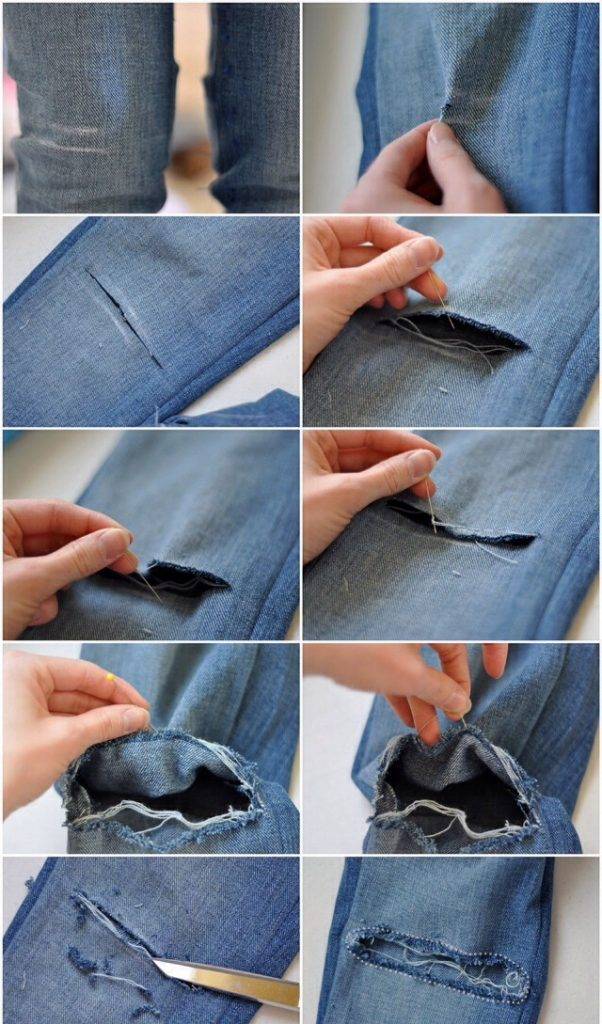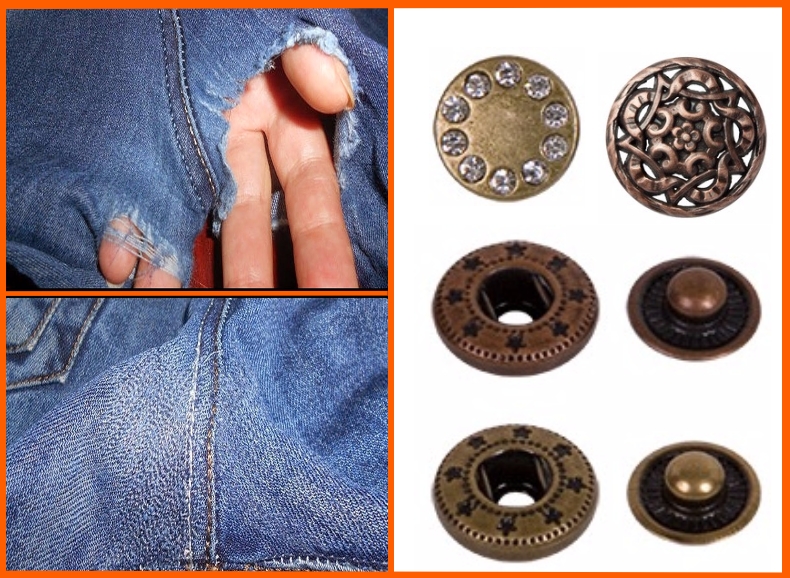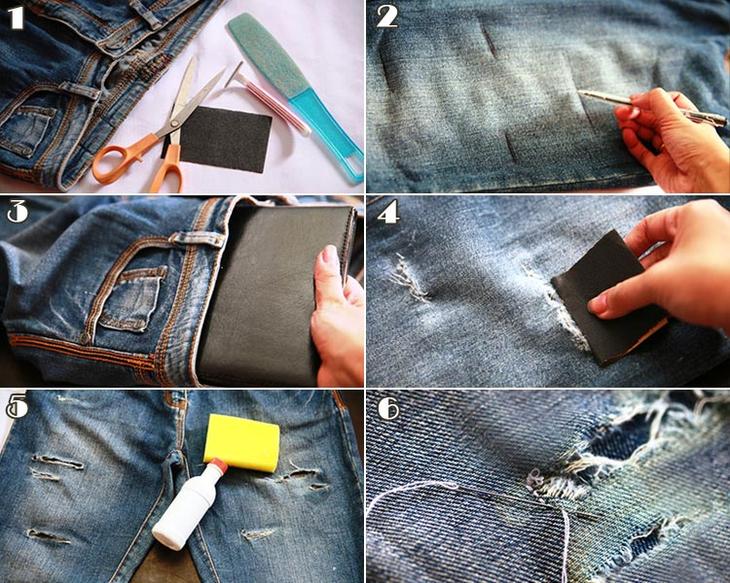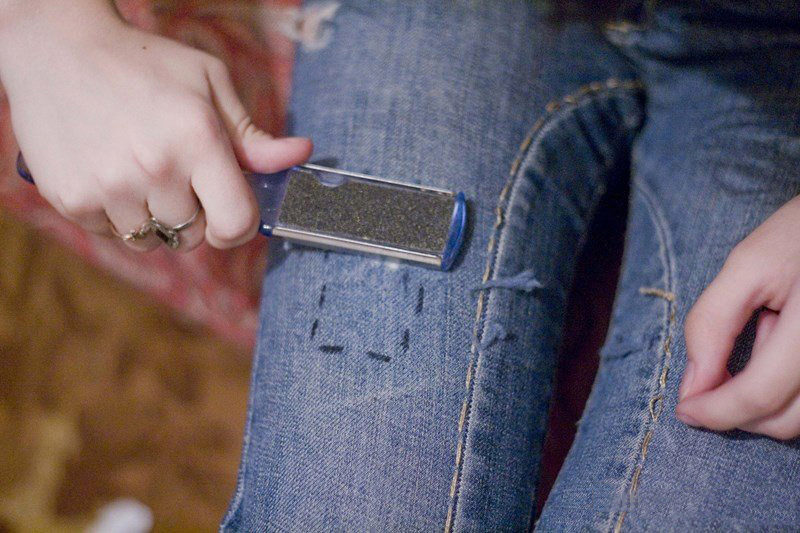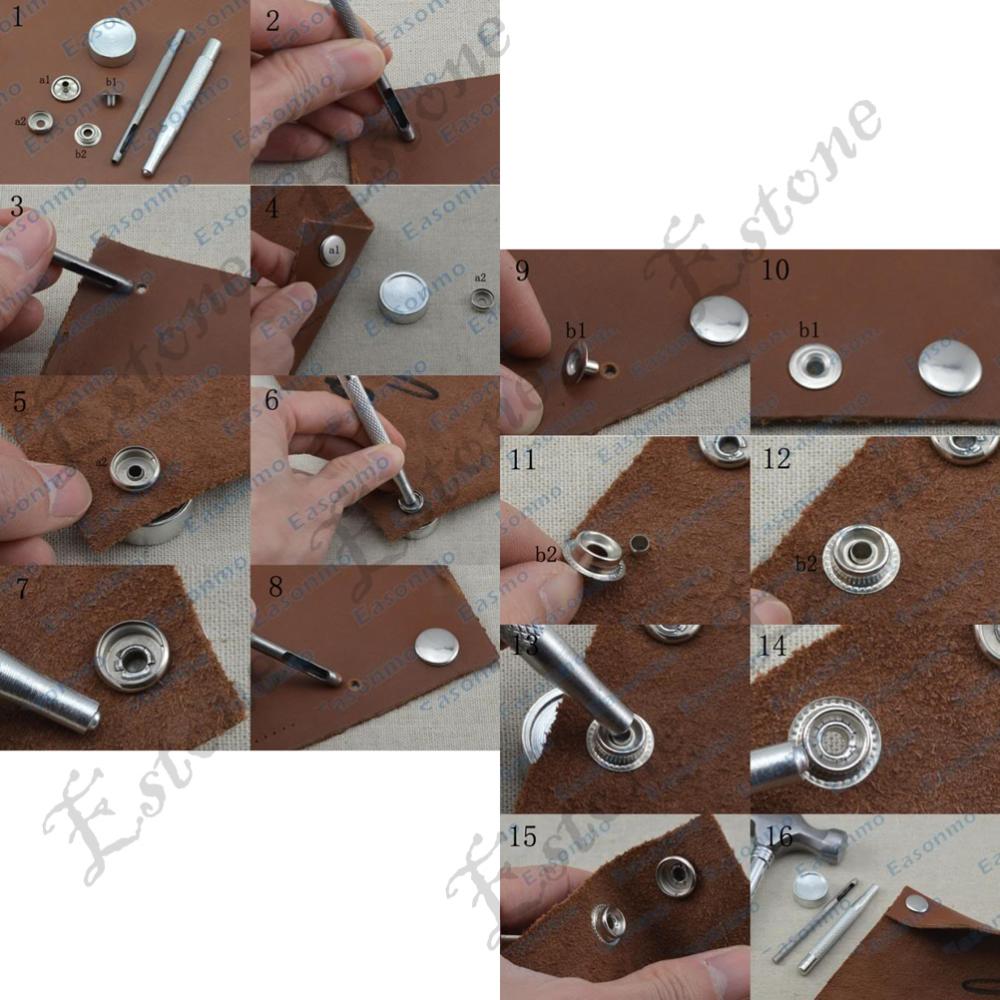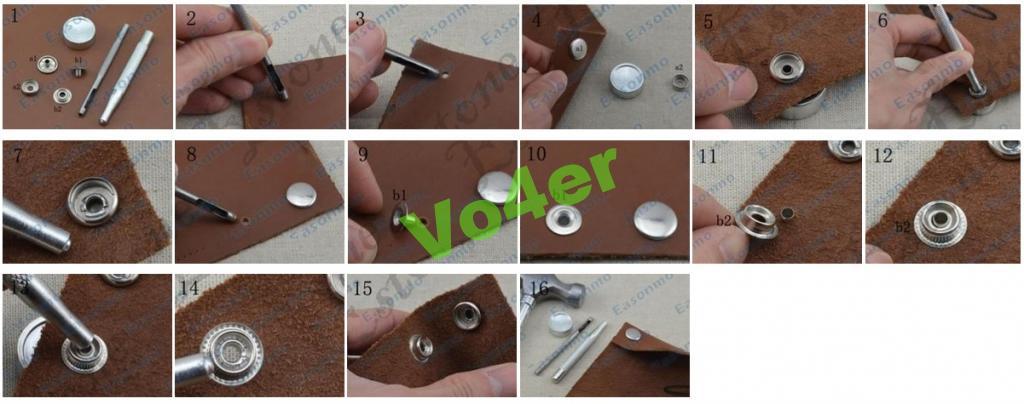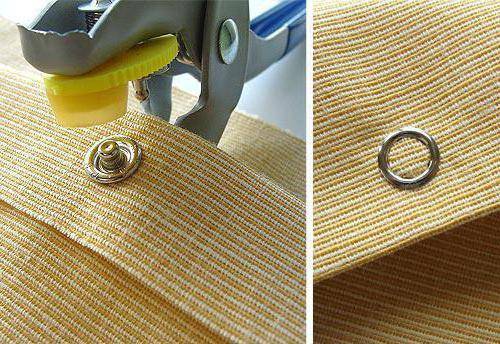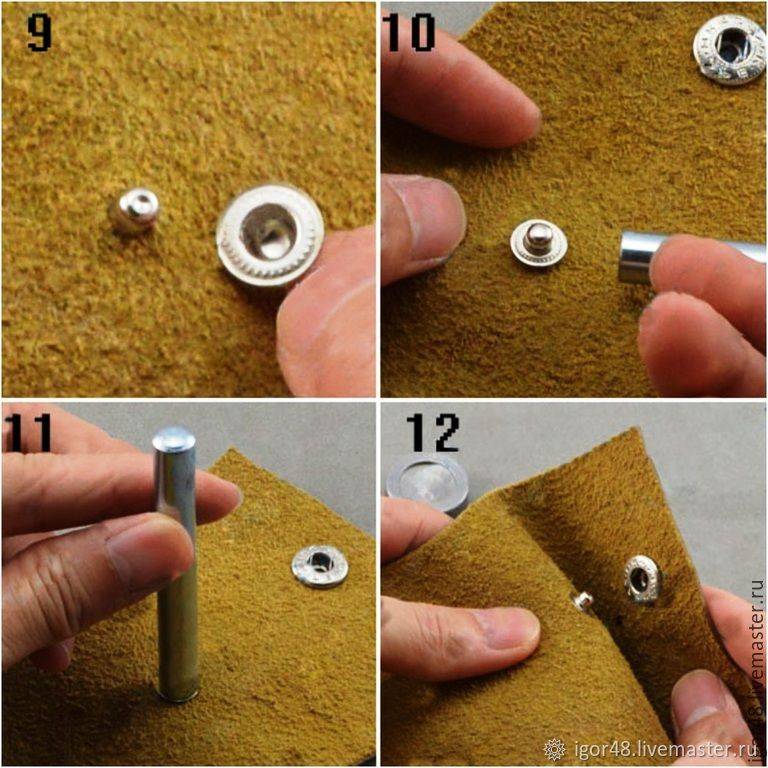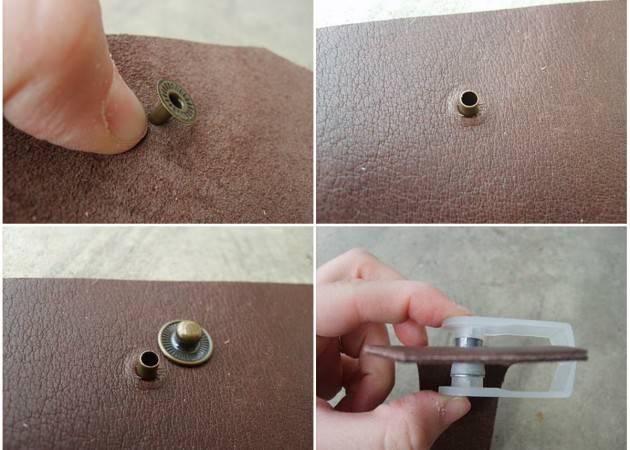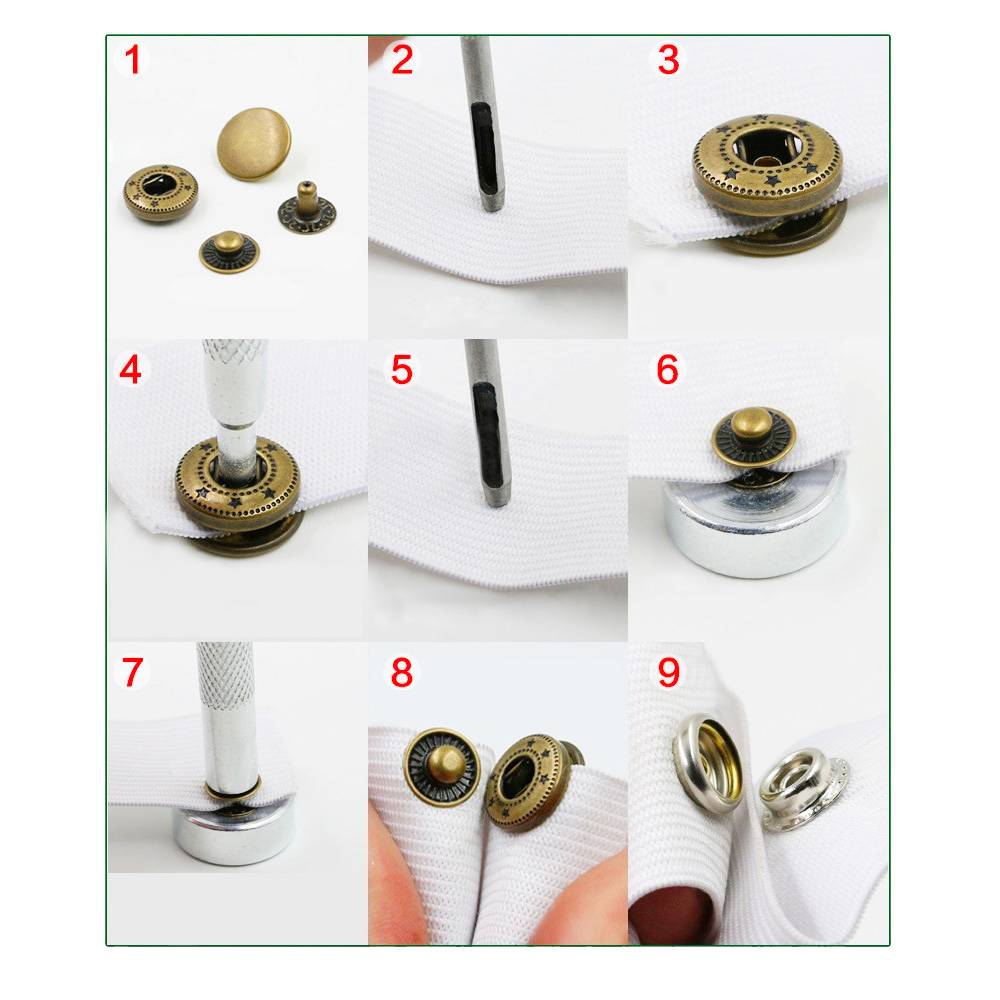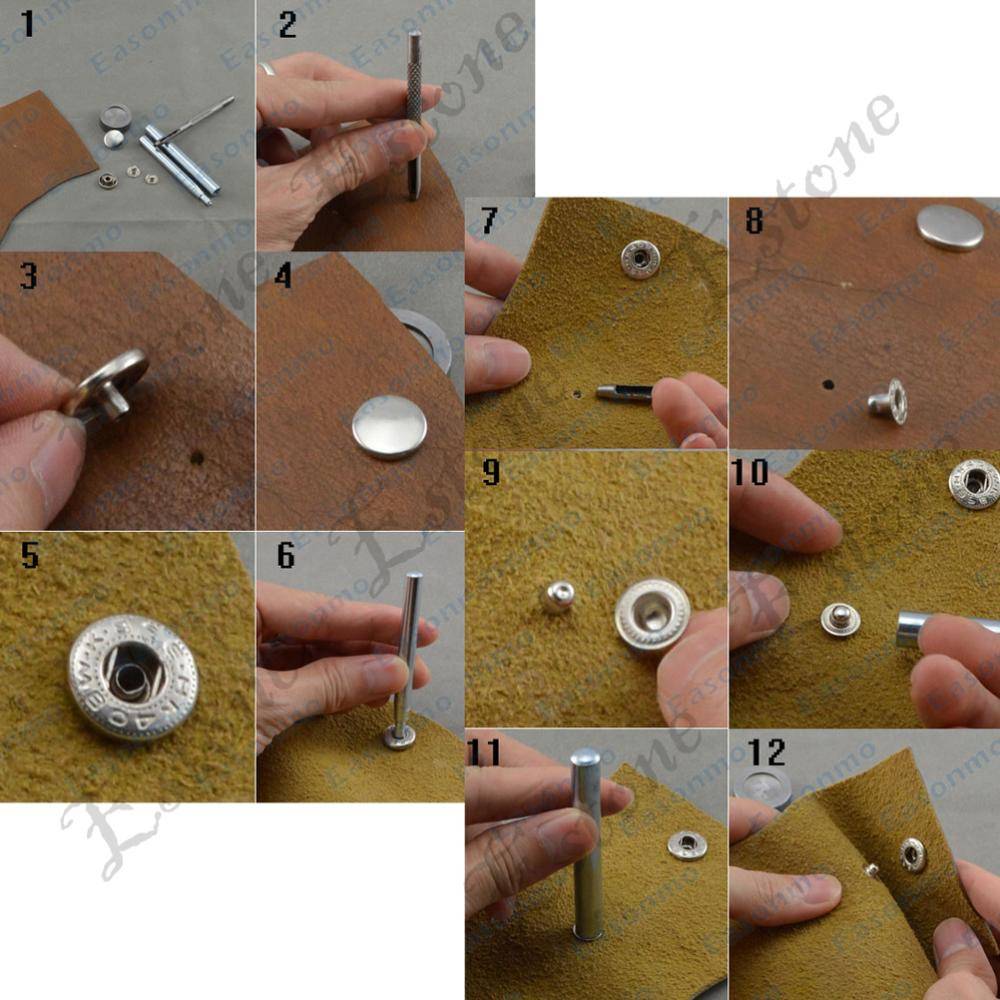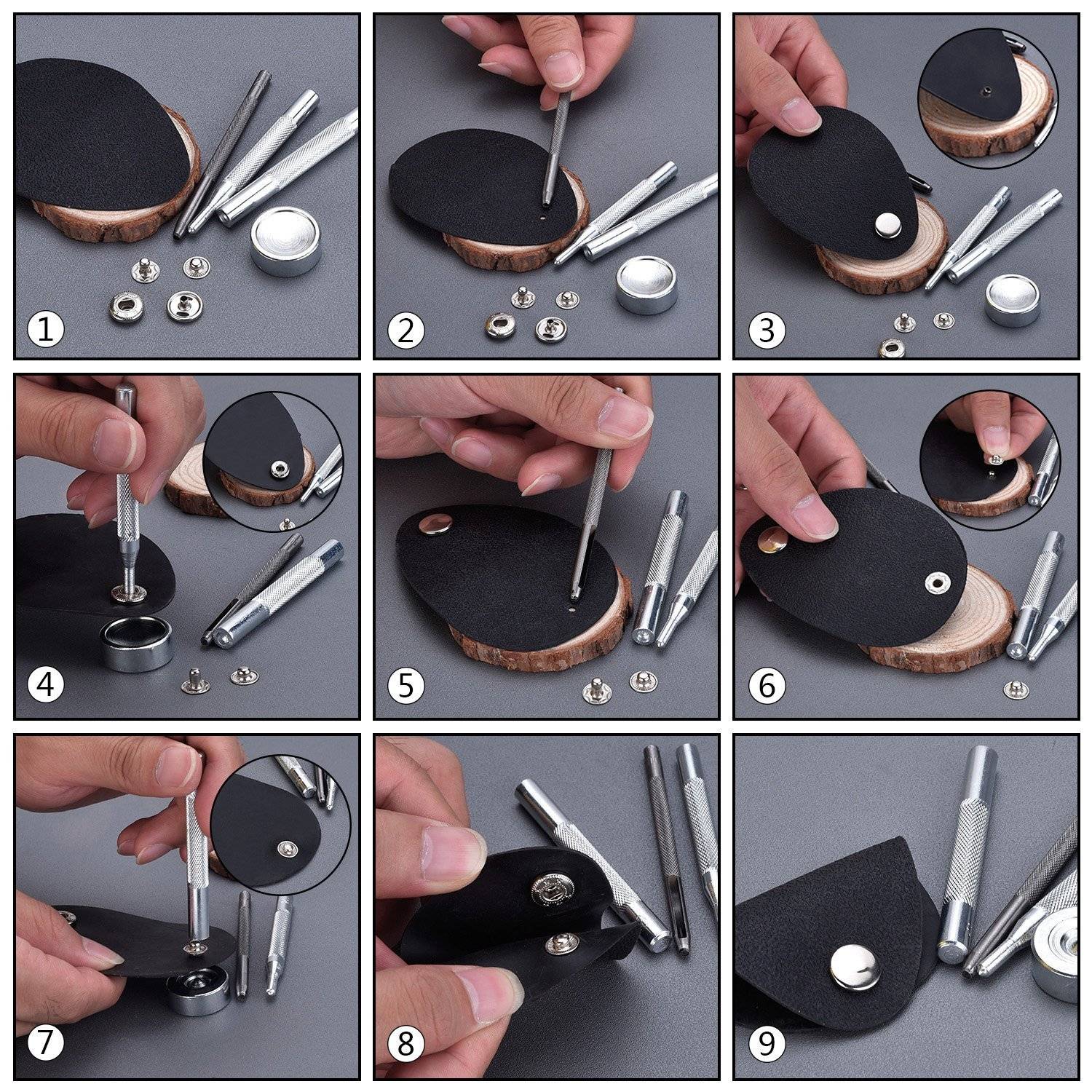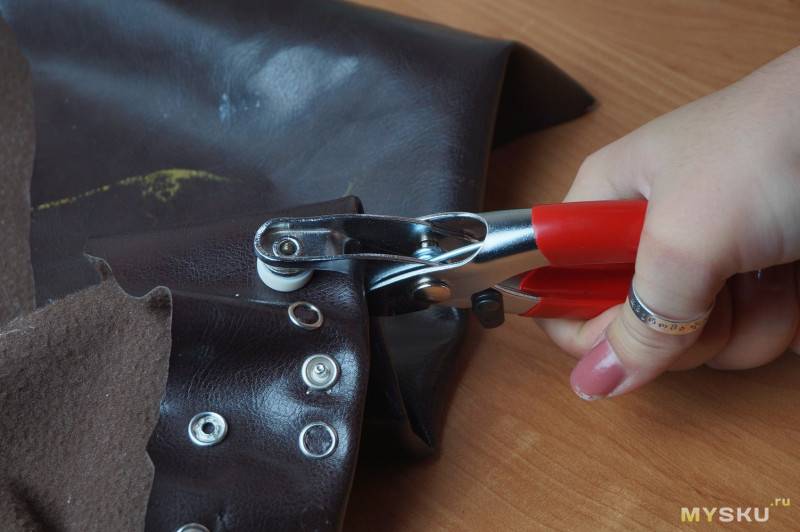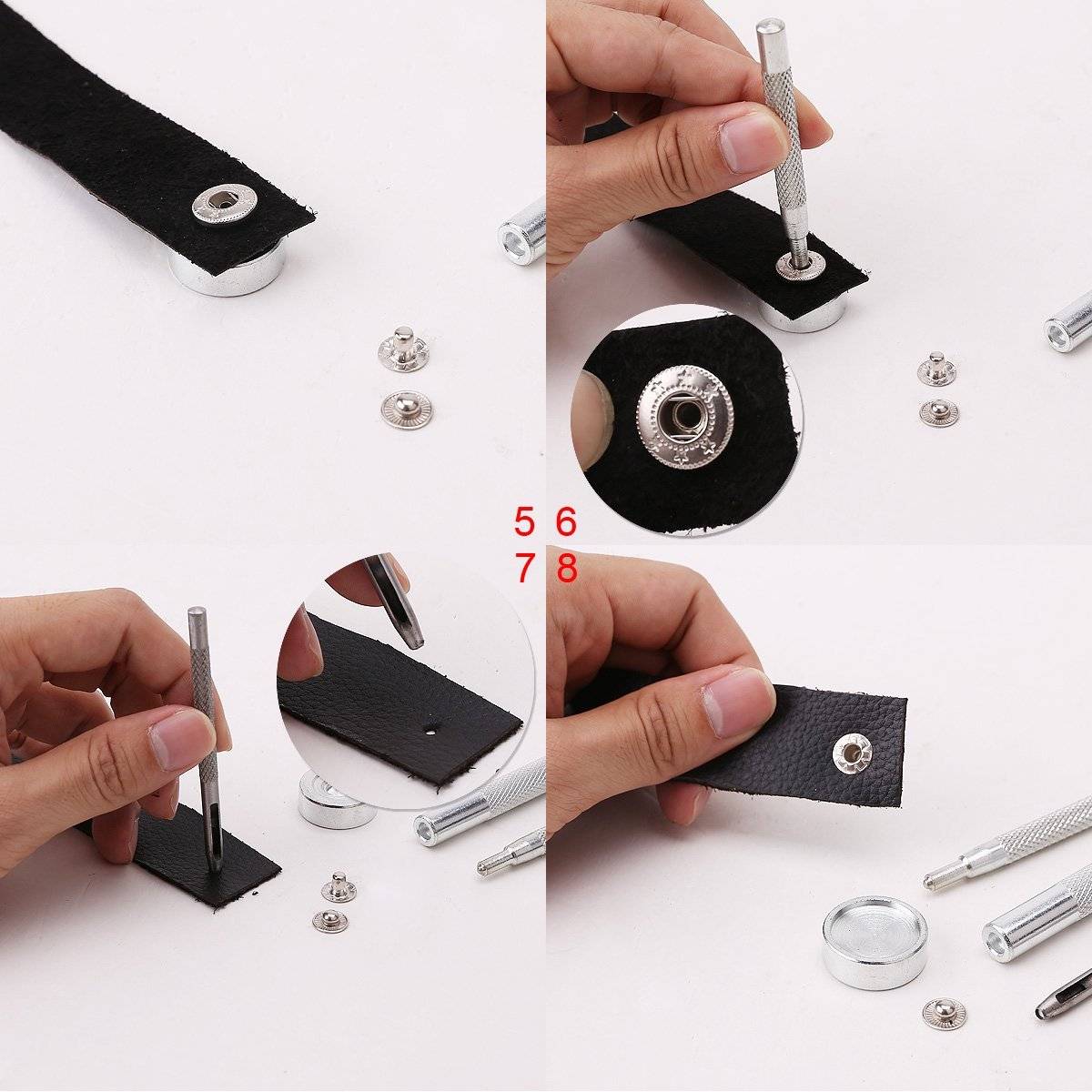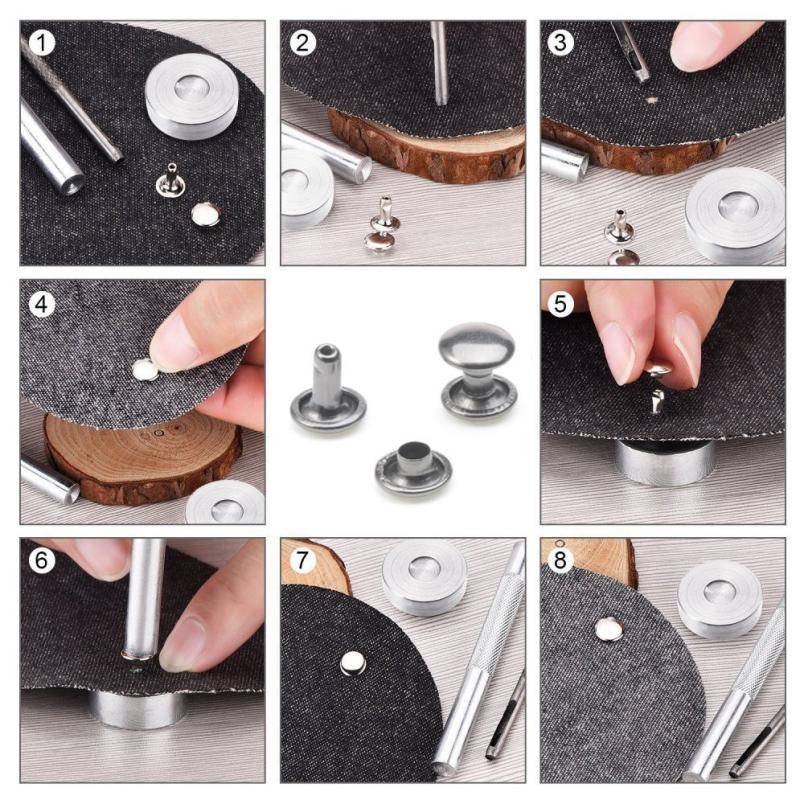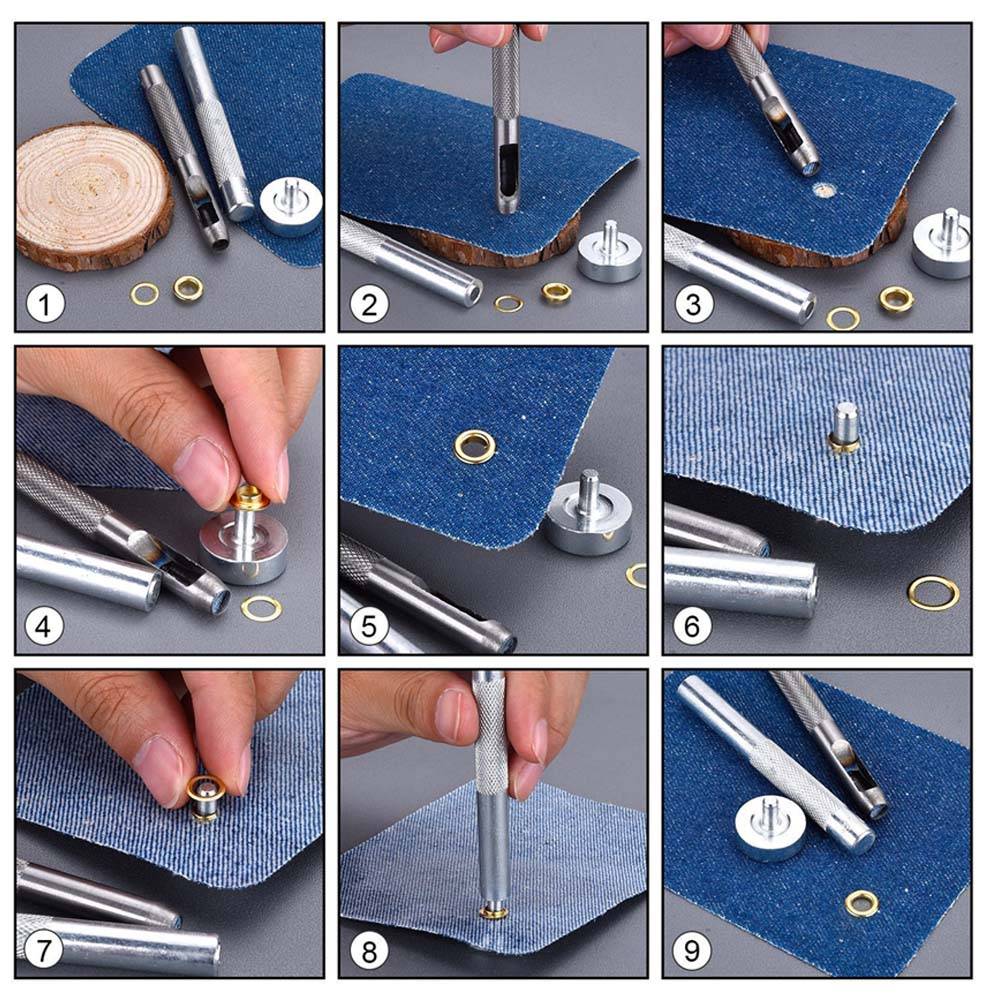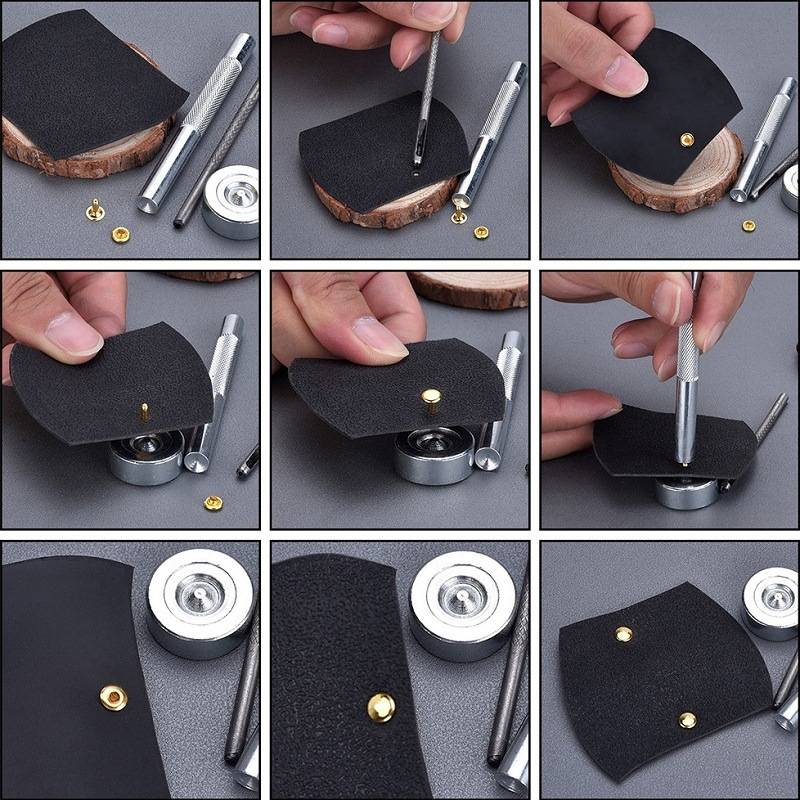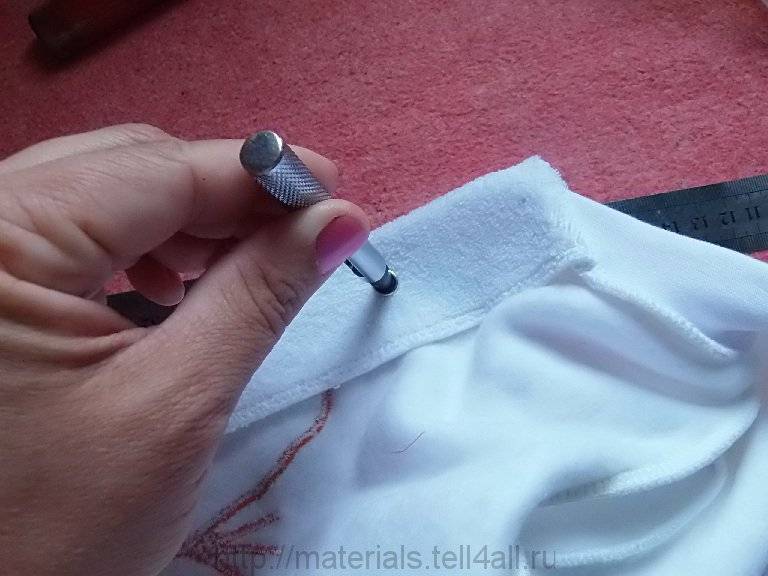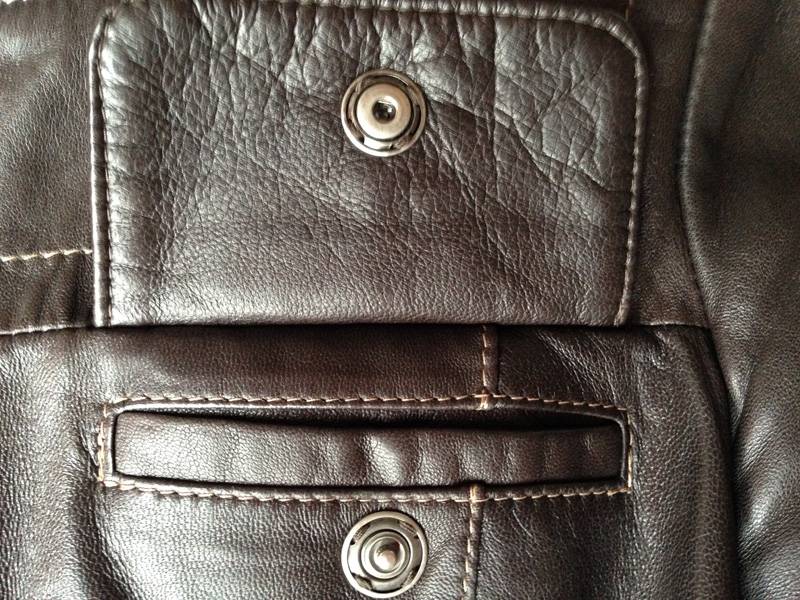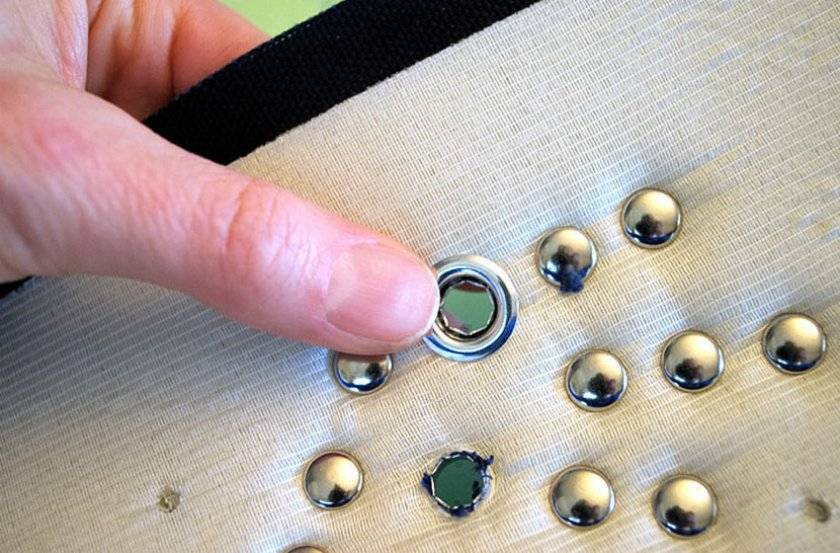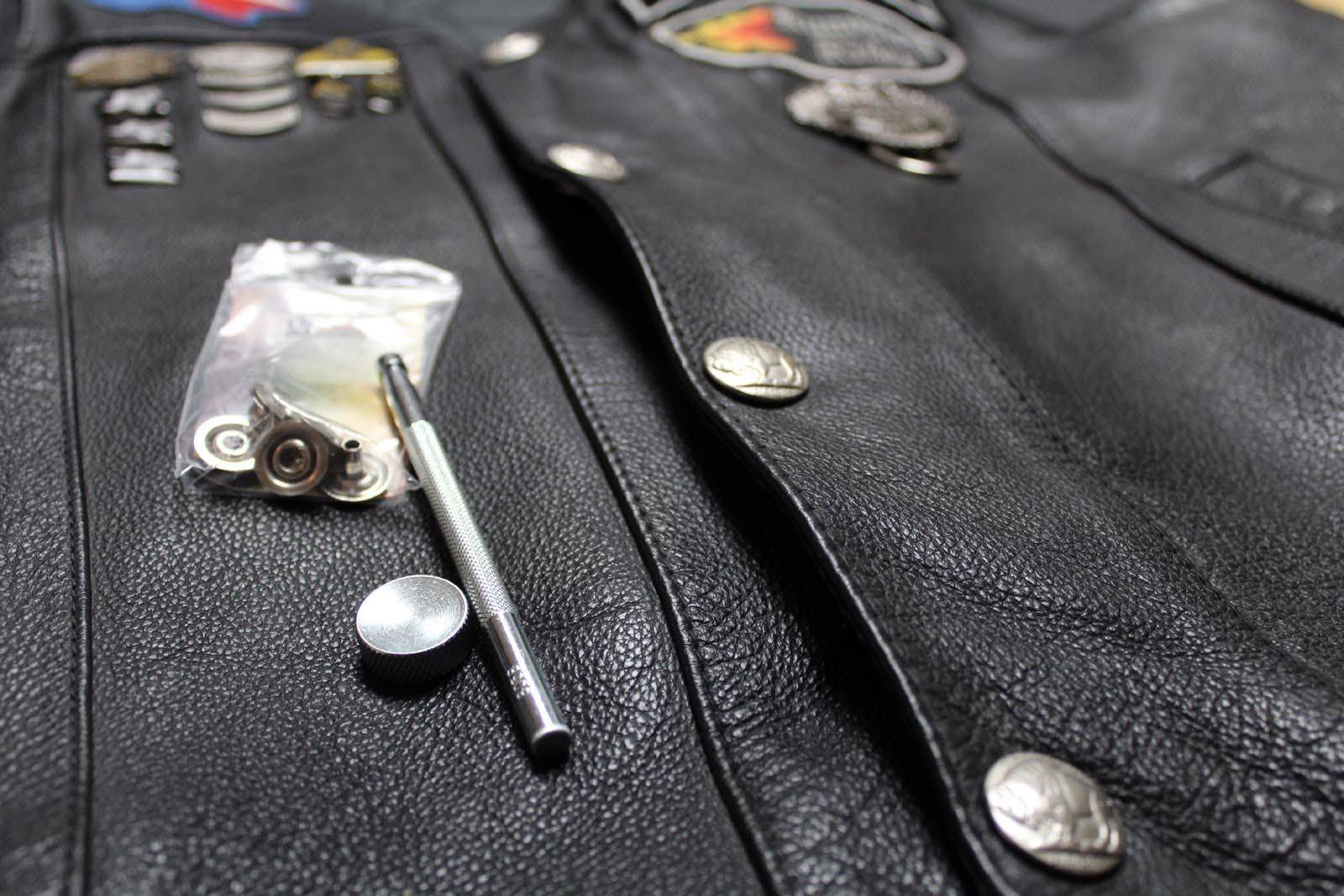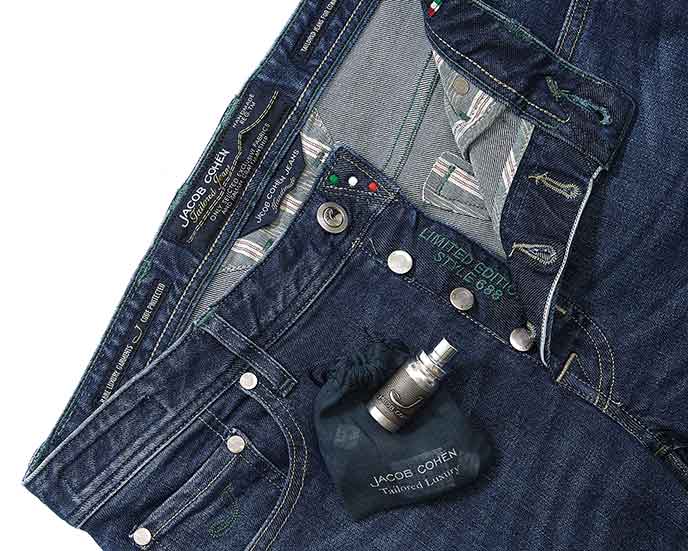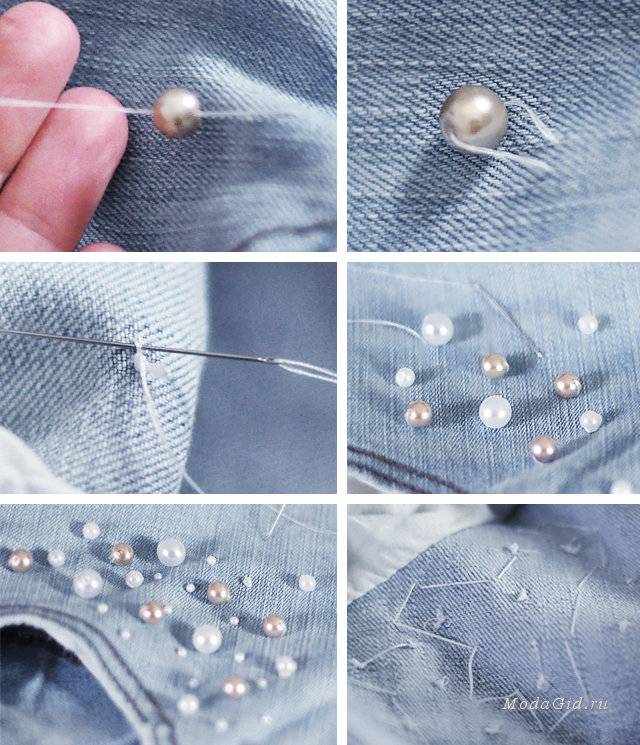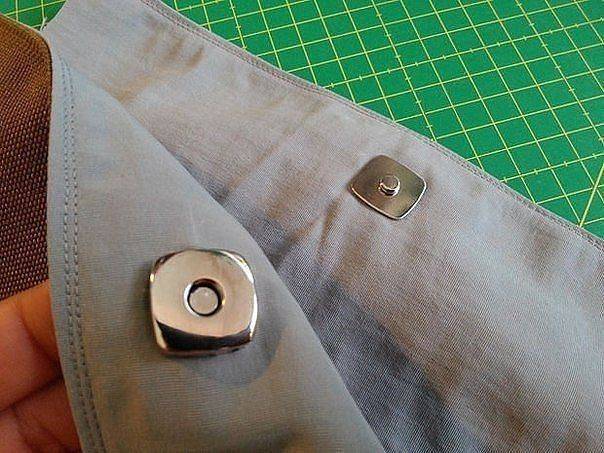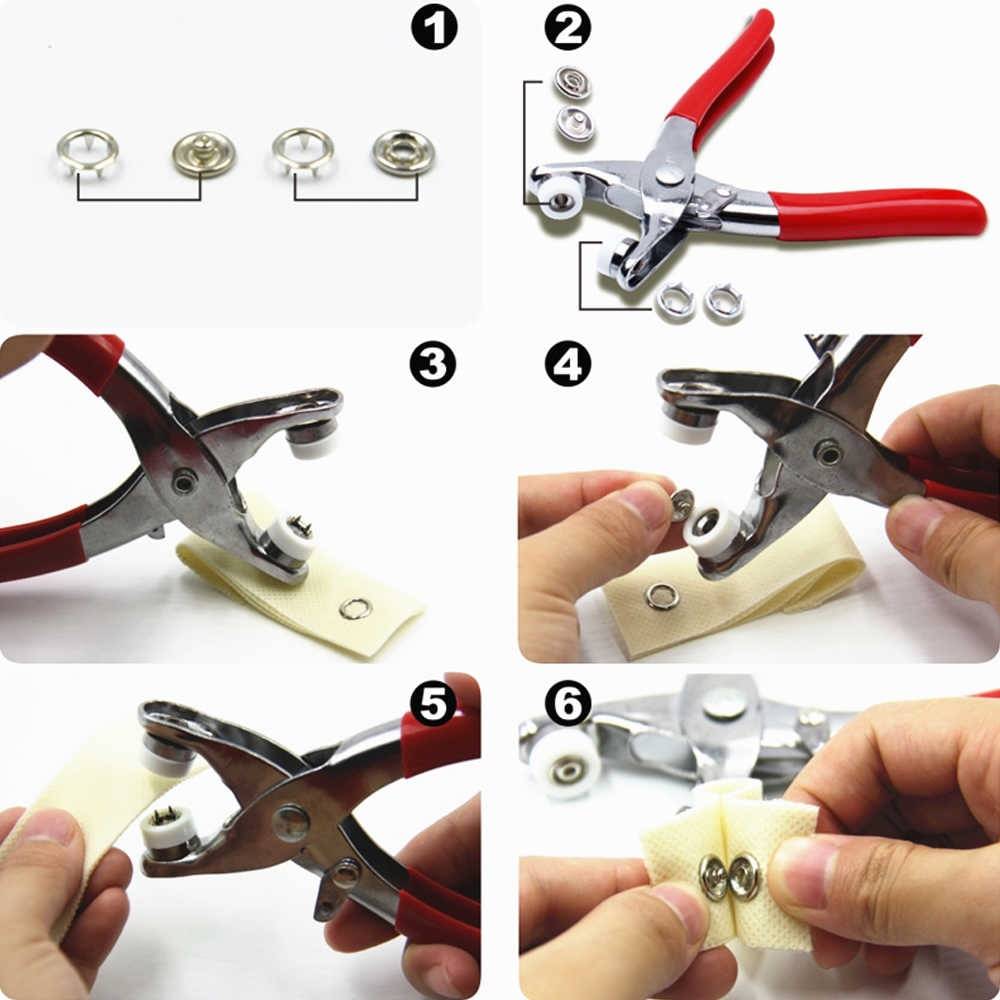The nuances of installation on:
In order to properly fasten rivets to clothes, you need to know the principles of the procedure in different cases. You can install the fittings:
- For the finished product;
- For a detail when sewing;
- Jeans.
Below are several technologies for working in different cases.
Ready product
A button is a round piece of metal or plastic used to fasten clothing. There are several types of devices: copper, aluminum, steel, iron. Additional tools are used depending on the type of material.
For self-installation, the use of a mounting kit for installing buttons on clothes will help. It consists of 11 items, each of which is designed to work with different types of fittings of various diameters. The kit will help you fix the device on clothes, shoes, bags, wallet, as well as other handicrafts.
The order of work, how to install rivets for ready-made clothes, will be as follows:
- Product preparation;
- The use of a special tool;
- Functionality check.
First you need to prepare the product: carefully smooth it with an iron, and also outline the places where the buttons will be located. It is then recommended to use a special fitting tool and a hammer. Better to take a small hammer for convenience. The tool is installed on both sides where the clothes will be fastened, after which they are hit with a hammer several times. Then the buttons are carefully separated from the fixture. There are already 2 buttoned button parts on the product. The last step is to check the operation of the buttons: it is necessary to fasten and unfasten the fittings several times in order to check the functionality and correct installation.

Detail when sewn
Often, manufacturers install accessories directly when sewing on parts, for example, when making pockets on denim. In this case, the block can be installed by sewing on or riveting with special pliers.
Before you buy a sew-on button, you should pay attention to its design - it does not have an expanding mechanism, but is equipped with holes for a needle and thread
Making a hole for the block with your own hands is not recommended. The most common mistake is using scissors. Then the hole turns out to be uneven and will become wider over time, because of which the button can easily fly out of the seat. Many people are interested in the question of how to strengthen the hole for the button: for this, you can use special glue - you need to walk the substance around the edges of the hole and leave it to dry for a while.
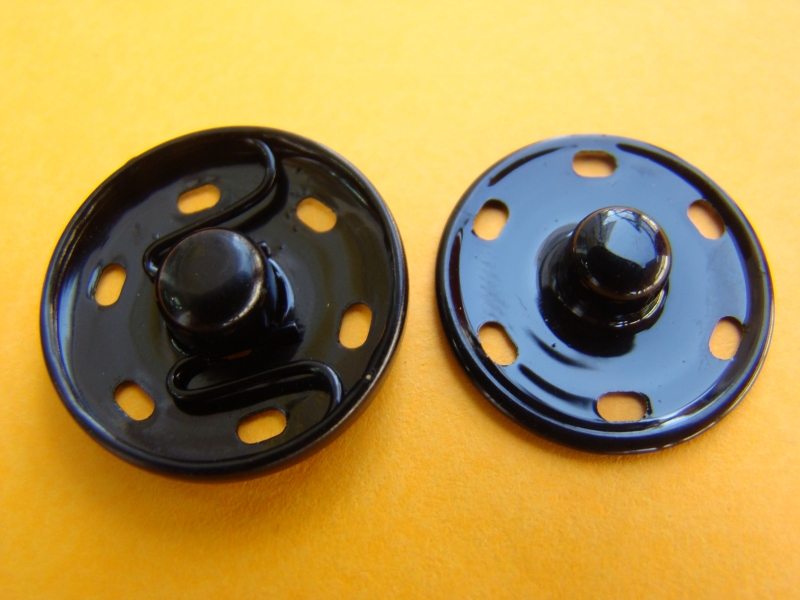 Choosing the buttons of the sewn-on type
Choosing the buttons of the sewn-on type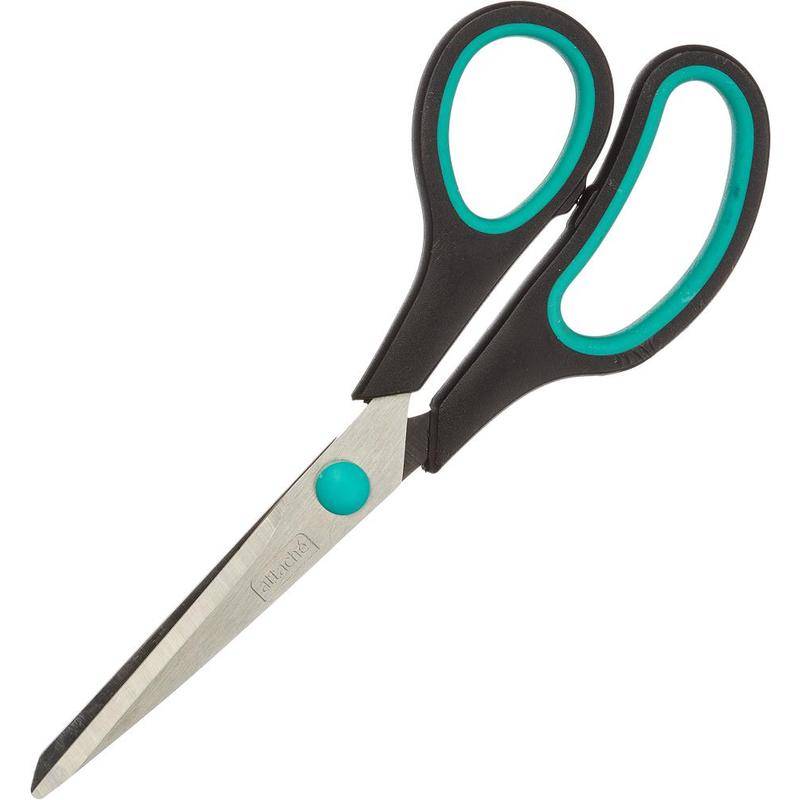 Don't use scissors
Don't use scissors Sew on the product
Sew on the product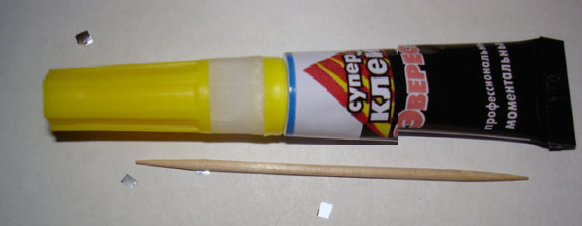 We strengthen the button with glue
We strengthen the button with glue
Jeans
The most common problem with jeans is that they come open. This means that the button is not securely installed. A small instruction will help you to correctly solve the question of how to rivet accessories on clothes.
| Stage | Description |
| Preparation | For beginners, the easiest way is to purchase the 4-part buttons. You will also need an awl, a splitting punch, to help the button open. |
| Hole creation | With the help of an awl, you need to make a hole in your jeans. |
| Installation | Next, you need to insert the button leg into the hole. |
| Fixation | After that, you need to place the button on the product on the anvil and hit it with a hammer. |
Next, you need to remove the anvil and check the functionality of the button by opening and closing it several times.
 Choosing buttons for jeans
Choosing buttons for jeans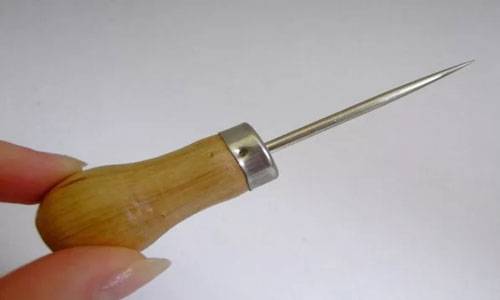 Preparing the awl
Preparing the awl Making a hole with an awl
Making a hole with an awl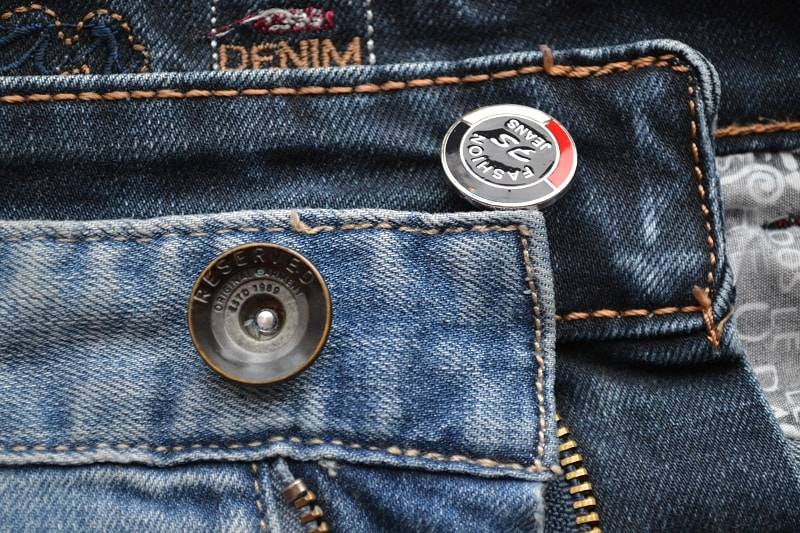 Fasten the button leg into the hole
Fasten the button leg into the hole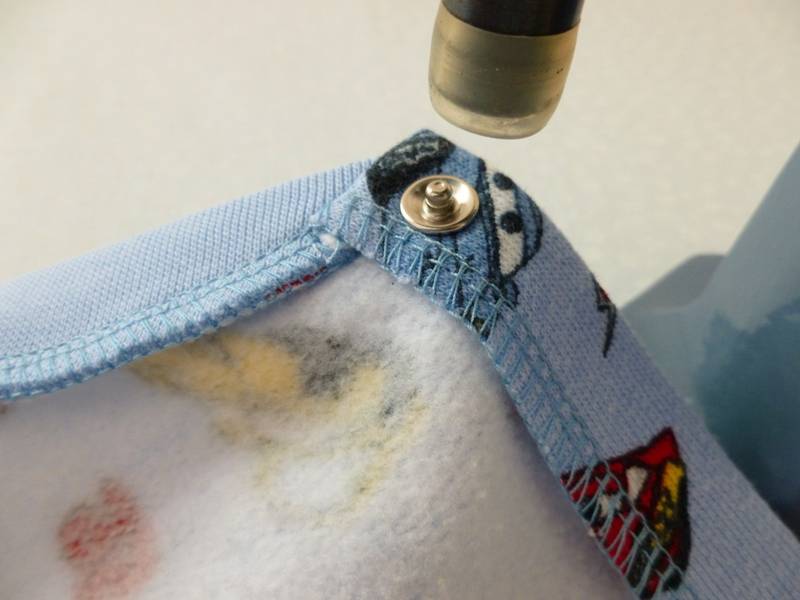 Fix with a hammer
Fix with a hammer
6 Assembling the antennae
The antennae button is considered a universal piece of clothing, as it is suitable for almost all types of fabrics. Out of inexperience, many refuse this piece of accessories, but in fact it is very easy to install the antennae button if you do everything according to the instructions. You need to start from the bottom part - it is assembled according to the following instructions.
- Place the convex part on the desired area of clothing through a metal plate with the same hole in diameter, or use a special tool (sold in sets with buttons).
- Fix the back part with a hammer, first bending the petals of the leg.
Important! This type of hardware is very difficult to install without a specialized tool, so it is better to buy immediately with a manual machine in the set. If you could not find an installation tool on sale, you should buy more buttons in order to experiment initially on unnecessary scraps of fabric and not ruin the thing.
How to replace correctly
The procedure for replacing the matrix depends on the specific TV model. Differences in the procedure for disassembling and installing a new element are associated with the unequal design of the devices. Screws or latches are used as fasteners. Disassembly of the TV is carried out from the front or rear side.

With frontal access, the latches holding the TV panel lining are squeezed out. After detaching the latches, access to the matrix is opened, which is screwed to the case. For dismantling, remove the fasteners on the back wall, then install a new component and reassemble in the reverse order.
Since screws of different lengths are used on the case, it is worth remembering their location. Having disassembled the case, it remains to remove the matrix and install a new screen.
The procedure for installing the matrix itself is not particularly difficult, but it is important to follow the sequence of actions. In particular, the following steps need to be followed:
- After disassembling the case, you can see the matrix on which the electronic boards and cables are fixed. The components are turned off after taking a photo of their location.
- Disconnect the cables along the perimeter of the TV. In some types of devices, the loops are hidden under the frame.
- Having removed the matrix, it is placed next to the serviceable one and the modules and electronic boards are transferred one by one. Immediately after transferring the board, a corresponding loop is connected to it.
- When a set of modules is connected, the case is assembled and the display is checked for functionality.

In order for the device to work properly, it may be necessary to match the new matrix with the modules. To do this, you need to turn on the TV, go to the settings and run the corresponding function. The detailed process is described in the instructions attached to the technique and may vary slightly.
What glue is suitable for repairing awning of trucks
The awning is a canvas made of synthetics, banner fabric, tarpaulin, PVC. For the repair of these materials, only certain compositions are suitable, which ensure a reliable connection of several spare parts with each other.
3> Special glue for PVC "Vinstik"
Glue solution "Vinstik" for PVC allows you to create a strong and transparent seam, resistant to the influence of liquids, while maintaining the elasticity index. The composition dries up within a couple of days at room temperature.
"Desmokol"
Desmokol polyurethane glue is intended for repairing PVC fabrics. The solution is transparent, therefore it does not leave marks and streaks after drying. Due to the high flammability during work, it is necessary to avoid contact of the substance with heating devices or open fire. After application, the solution provides a strong connection of the surfaces, without the risk of displacement and tearing of the patch from the awning structure.
"Cosmophen"
The "Cosmofen" mixture has universal characteristics, which makes it possible to use it in work with any materials. Fast-setting cyanoacrylate glue is easy to apply and requires tight compression of the treated area with a press for a strong bond. The mortar undergoes ambient temperatures up to +80 degrees, therefore, the seam should not be exposed to more heat so that the glue does not melt. Due to the release of toxic components when using "Cosmofen", it is necessary to repair the car awning in a constantly ventilated room.

Rapid
The thermoplastic compound of the Rapid brand reliably removes defects on the tarpaulin, maintaining the tightness of the web on the damaged area. The adhesive must be used in combination with a hardener and heated before application. The solution is suitable for repairing fabric tarpaulins.
Button replacement instructions
To install a new fastener, you need to perform several operations:
- Dismantle the old one if it is out of order.
- Use an old hole or make a new one.
- Thread the button through the hole.
- Put on the fixing ring.
- Use a flat surface to install the clasp.
- Divide it into four parts with a punch.
- Roll the petals with a hammer.
It is worth having a few spare buttons so that there is something to replace the damaged ones, since the pin petals often break.
Removing an old button
Removing an old, broken push-button fastener is easy, but it is important not to damage the fabric. You should prepare a pair of pliers and a knife whose blade does not bend
You should prepare a pair of pliers and a knife that does not bend the blade.
Procedure:
- On the lower part of the fastener, carefully slide the knife blade between the button and the material from the inside of the product and fold back the metal edge.
- Do the same on the front of the garment symmetrically to the wrong side.
- The edge should be folded back so that you can grip it with pliers.
- On both sides of the fabric, grasp the folded edges with pliers and, using a slight effort, separate the two parts.
- To remove the upper part with pliers, take its front and back part and, twisting it, separate it.
Bonding the front
To attach the front part, perform a number of sequential actions:
- Prepare a wooden board.
- Make a hole for the fastener with a thick awl or punch.
- Insert the button cylinder into the prepared hole.
- Put on the spring part from above.
- Fold in the edge using a tapered awl.
In order to avoid rapid precipitation of edges on the synthetic fabric or the formation of torn edges, the awl is heated over a fire before piercing the fabric.
Assembling the back part
To assemble the lower part, you need to prepare a small device. It is a plate with a hole in the size of a slightly larger part. A hammer with a flat striking surface is used as a tool.
The order of performing the operation is as follows:
- Make a hole with an awl or punch.
- Insert the button into the recess.
- Pass the fabric into the second part of the back.
- Combine both parts.
- Connect the parts with a slight blow of the hammer.
1 Types of fittings
Clothing accessories are divided into the following types:
- Buttons.
- Velcro textile fasteners.
- Blocks.
- Lightning.
- Hinges.
- Hooks.
- Holniten.
- Buckles.
- Eyelets.
- Rivets.
All fittings are made from different materials. More often than not, quality plays an important role in shaping the value and durability of the product itself. Any accessories should, first of all, decorate clothes, therefore, their selection should be treated responsibly.
Clasps can be made from different materials, including:
Sometimes fittings are made from several materials in order to add beauty and style to the product. In these cases, you should select the fasteners already for the very element of the wardrobe.
If you choose the wrong fittings, the entire product may become unusable. Don't skimp on fasteners, as low-quality buttons and hooks can let you down at the most awkward moment. to the menu
What do the numbers mean
The numbers refer to the dimensions of the teeth: they show the width in millimeters when the zipper is closed. Marking is applied to the slider from the inside. The shape of the top of the tongue depends on the type of links.

Metal prongs are 3, 5, 8, 10 millimeters, the top of the slider has a triangular shape. Cast plastic teeth (tractor) - 3, 5.7, 8, 10 millimeters, oval or trefoil slider. Twisted plastic links (spiral) - 2, 3, 4, 5, 6, 7, 9, 10 millimeters, the slider resembles an oval. The longer the prongs, the stronger the tensile and tensile bond.
Metal clasps
The metal zipper teeth are made from flat brass or nickel wire. The shape of the links is asymmetric: on one side there is a protrusion, on the other - a depression. The connection with the tape is double-sided. The grip quality is high, but due to the skewed teeth, the runner can "stick".
Tractor lightning
The clasp consists of wide plastic teeth fastened to one side with a dense webbing. The shape of the links resembles a tracked track. The advantage of such a zipper is the durability of the links. But according to the method of fastening, it loses in strength to metal and twisted fasteners.
Twisted clasps
The zipper is made from a coiled line. The fiber is wound or sewn onto the braid. The adhesion is formed by the fiber protrusions on both sides.
Video
Rivets for clothes are invisible, but irreplaceable details of every thing, from fur coats, sheepskin coats, jackets to underwear. If you learn to work with a variety of sewing accessories, you can always repair any decorative elements without resorting to the services of a master. We hope our tips and tricks will help you along the way!
How to strengthen the button on the jacket so that it does not open?
How to strengthen the button on the jacket so that it does not open? The button is constantly unbuttoned on the jacket, is there anything you can do?
toshiba
Achievement received on 05/17/2019
The garment button consists of two halves, one of which contains a spherical protrusion followed by a narrowing. Outwardly, this ledge is very similar to the top of a chess pawn. The second half has a cavity in the form of a blind hole, inside which there are two pieces of steel spring wire. In the process of fastening, the spherical protrusion moves the spring wires apart. This continues until the parted antennae reach the narrowing point. In a narrow place, the wires come together, and this ensures a reliable connection of both fastener elements. During unbuttoning, the process is repeated in the same order.
There are only three reasons for button incontinence and all of them can be easily eliminated. The first reason is that on the half of the button where the spherical protrusion is present, there is too little difference between the widest part of the sphere and the narrowed part. The closed wire whiskers, at the slightest pull, immediately disengage, barely moving apart. The defect is eliminated either by cutting out a deeper groove at the point of narrowing of the protrusion (if the thickness of the metal allows), or by forming a more embossed depression by crimping the protrusion of the button using conventional pliers. The main thing is not to overdo it and not bite off the protruding element at all. Therefore, the operation should be performed without undue effort, without trying to perform it in one step. It is better to make several light crimps evenly distributing them over the entire diameter.
The second reason lies in the counterpart of the button with springy wires. They may initially be divorced too widely.You can bring them closer and reduce the distance between them with round-nose pliers with narrow lips, tweezers or tweezers from a ladies' cosmetic bag. If the button uses a low-quality wire that does not restore its shape well, then the procedure will have to be repeated regularly, as the fastener looses. The risk of breaking the wire tendrils is low, as the wire breaks only at sharp bends.
Reason number three is masked under the guise of an external inclusion, again in the counterpart of the button. A foreign inclusion can be debris accidentally stuffed into a blind hole, for example, in the form of fabric fibers from clothing. This debris significantly reduces the tenacity of the fastener. First, it prevents the wire springs from fully closing. Secondly, the speck does not allow the protrusion of the button to fully penetrate deep into the hole in the counterpart. Even if the springs are of high quality, they simply do not reach the place where they are supposed to dock and arrive in a semi-open state. In this case, the problem is eliminated by elementary cleaning of the counter part of the button and removing the blockage with a thick sewing needle.
I first encountered the problem of weak buttons in the early nineties, when merchants-shuttle traders in huge quantities purred leather jackets from Turkey. Since then, the buttons have not gotten better. With our own hands, we managed to restore the functionality of several dozen buttons. All are working properly.
How to install a button on clothes at home?
Of course, if you have the opportunity, then entrust the installation of accessories to a master who has a special press, various devices, a set of tools, and most importantly - experience, thanks to which such work will not take him much time. If you do not have such an opportunity, or you want to find out for yourself how to install a button on clothes, then prepare the following tools:
- Awl.
- Hammer.
- Forceps.
- Punch. This tool will have to be purchased. It is necessary so that the hole turns out to be even, and the edges of the fabric do not crumble.
Advice:
- Do not cut a hole under the block with scissors, as over time the button or block will surely "fall out" from it. The hole for the button should be minimal, it is advisable to even slightly pull the fabric over the leg, since the tighter the fabric is pressed against the part, the more securely it will be fixed.
- Punch a hole in leather or fabric on a wooden (not metal) anvil to avoid damaging the punch point. The tree should be very dense (not loose). An area with a knot will do. Other dense materials can also be used as anvils that will not damage the punch.
- Areas on knitted and loose materials where holes will be punched can be glued with an adhesive cloth so that the edges of the hole do not crumble. You can also process the edges of the hole with silicone glue.

Rivet installation process
It is necessary to work with the tools carefully, slowly and without making any sudden movements. Otherwise, the fabric, accessories or tools may be damaged.
The most common type of fittings installation is the installation of a block on clothing. In workshops and ateliers, forceps are used for this procedure. However, such a tool should be bought of good quality so that the handles do not bend and the “cheeks” do not move.
Do not despair if you do not have special forceps at hand, you can do without them at home. Use the following step-by-step instructions:
- Punch a hole of the required diameter in the textile or leather.
- Pass the leg-block, put a ring on it.
- Place the patch of clothing with the sequin on the anvil.
- Use a punch to split the leg of the block into petals. If all steps are done correctly, then the petals should bend themselves on the block ring.
- Walk over the block with a little hammer to secure it to the fabric.
When working, lay the ring with the convex side away from you so that it repeats the convex shape of the edge of the block.
How to attach buttons to clothes?
The most difficult process is installing rivets on the rough fabric, from which outerwear is often made. Difficulties also accompany the installation of rivets on jeans. But if you use a good tool and follow all the technological steps, then you will probably be able to fix the button on the clothes.
You will need the same tool as when installing the block. Sometimes, for this type of buttons, special punches are included in the kit, but they are ineffective to use. It is much more convenient to use a punch that splits the leg into petals.
To make a rivet on a jacket or other outer garment, proceed as follows:
- Unfold the leg of the four-part button at the top and bottom.
- Follow the standard riveting process (described above).
Self-installation of the button on the clothes
Of course, a guaranteed result will be given only by a master with special equipment, a professional set of tools, a number of devices and vast experience. But it so happens that there is no time or money at the atelier, so you have to install the button on your clothes yourself at home. This is not so difficult to do if you prepare the following tools:
- Forceps.
- Hammer.
- Awl.
- Punch - creates even holes, you need to buy it.
Important! The punch is usually bought one, but with the right approach, it is better to purchase a set with replaceable nozzles. Anvil (can be adapted as a second hammer)
Anvil (can be adapted as a second hammer).
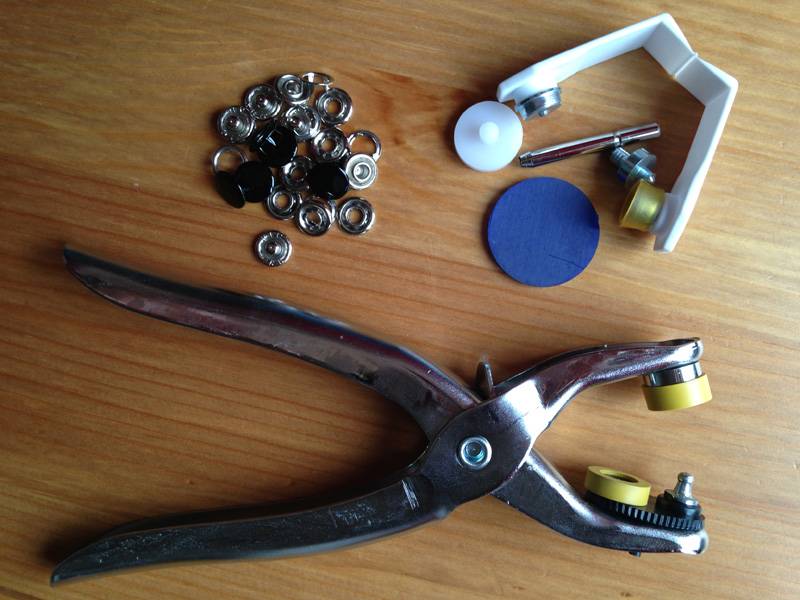
Recommendations
- Holes cannot be cut with scissors. The hole for the button should be small so that the leg of the button fits snugly and securely in it.
- When punching leather or fabric, it is better to use not a metal, but a wooden anvil made of dense wood (ideally, if it is an area with a knot).
- Areas on knitted and loose materials must be glued with an adhesive cloth, otherwise the edges of the hole will crumble. Alternatively, you can use silicone glue.
Important! To gain experience, it is better to start with inexpensive clothes, because in case of a negative result, it will not be as pity as branded clothes.
Installation of rivets
When working with tools, you need to act carefully, slowly without any abrupt movements and extremely carefully. If you hurry, then the fabric or accessories can be ruined.
The most popular type of installation is the installation of a block on clothing. Craftsmen use tongs that must be purchased from a tailor shop. A high quality tool should have rigid handles.
If there are no special forceps at hand, then this is not a problem if you follow these instructions:
- Make a hole in the clothes with a punch.
- Pass the leg-block, put a ring on it.
- Transfer clothes to an anvil.
- Using a punch, split the leg into petals.
- Tap the block with a hammer to firmly secure it to the clothes.
Important! Put the ring with the convex side away from you. When working with a hammer, do not apply excessive force, otherwise the block will break or the clothing fabric will tear
Attaching buttons to clothing
The most difficult and responsible process is the installation of rivets on outerwear. It is no less difficult to install rivets on jeans, but using a set of tools and carefully following the technological steps that are described in the article, you can make this task simple and real to perform.
Important! It is easiest to install buttons on outerwear, which are assembled from four parts connected by a ring. Having prepared a set of tools, you can proceed to installing buttons on outerwear, you need to do this as follows:
Having prepared a set of tools, you can proceed to installing buttons on outerwear, you need to do this as follows:
- We unbend the leg of the button from the bottom and top.
- We make a riveting process.
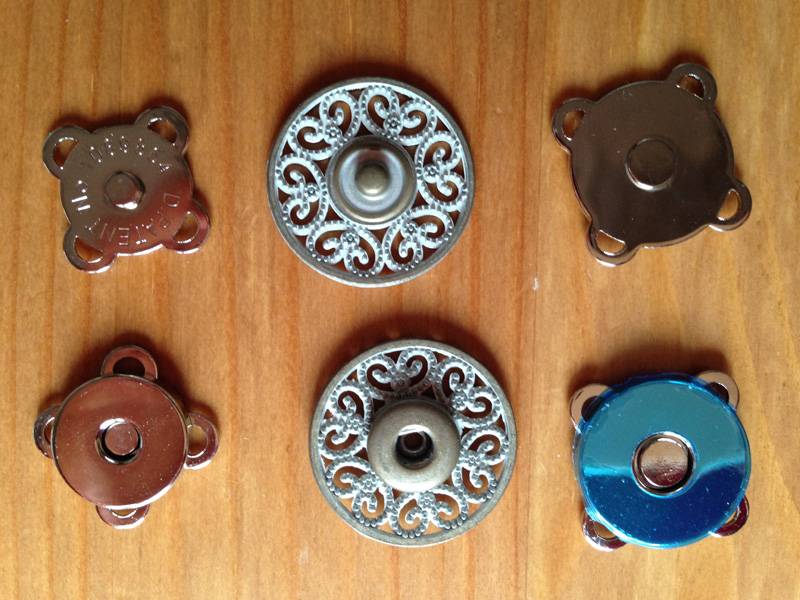
How to put on a denim button?
To install the simplest button on jeans, proceed as follows:
- Poke a hole in the waist of your trousers with an awl.
- Insert the button foot into the hole.
- Place the button on the anvil (on a metal surface) and hammer in the leg. It is the leg, not the button, otherwise you will damage the decorative element.
Important! To install a button of a more complex design, the leg of which will move freely, you will need a dowel cut down on emery, since the leg of such a button will need to be expanded on the button itself. Step-by-step instructions on how to install buttons on clothes at home:
Step-by-step instructions on how to install buttons on clothes at home:
- Pass the leg of the button through the belt.
- Place a button on the bar.
- Evaluate how far the leg comes out of the button. If necessary, “bite off” the edge of the part with pliers. Otherwise, the leg will bend and it will be impossible to expand it.
- Place the button on the anvil.
- Install the dowel on the center of the button leg, lightly tap with a hammer to flare the leg until it shrinks tightly with the head body.
1 Varieties of clothing accessories
In the process of sewing and decorating clothes and other wardrobe items, various types of accessories are used. They differ in the type of attachment, appearance and functional features. Metal fittings are presented in the following variants
- Holniteni - fastening rivets for denim.
- Buckles are functional and decorative.
- Hooks - used to create hidden fasteners, an alternative to buttons.
- Rivets are functional and decorative, they can be versatile.
- Buttons are the most common type of fittings, presented in various options and shapes.
- Blocks are metal ring-shaped stops that are used for lacing.
- Eyelets - fasteners for leather and textile products. The same blocks, but with an additional ring for fixing.
There are fabric, plastic and other options for fittings - zippers, hinges. All of the above types of fasteners, fasteners and other types of fittings can be not only made of metal, but also contain plastic elements, decorative stones and other additions. Choosing the right product is the key to success. If you pick up a product that is unsuitable in size, quality or style, the item will be damaged, or it will need to be repaired again after a short period of time.
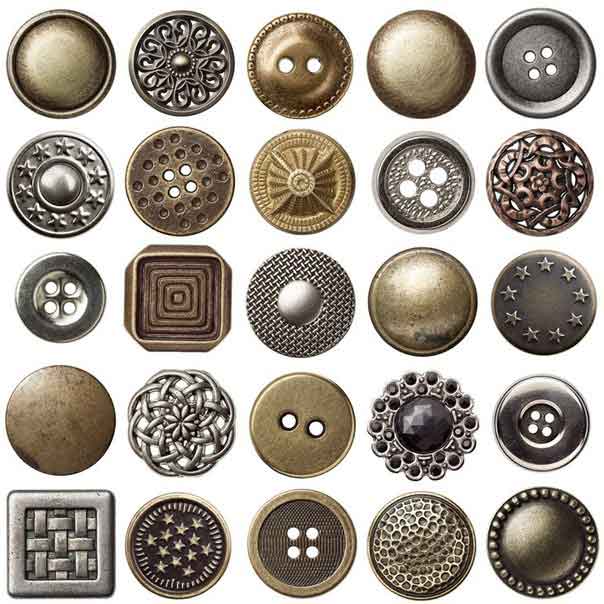 Various types of accessories (buttons, rivets)
Various types of accessories (buttons, rivets)

